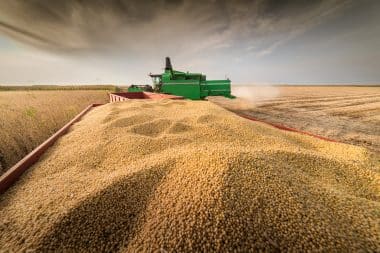How New Tariff-Related Shipping Fees Could Raise U.S. Food Prices and Threaten Supply Chains
Starting in mid-October 2025, the U.S. will impose steep new fees on container ships built in China or operated by Chinese-linked companies. While these are technically “port fees,” they function similarly to tariffs and could have far-reaching effects on the prices and availability of many goods… including food.
The policy, born from a Section 301 investigation into China’s dominance in shipbuilding and global maritime logistics, is part of a broader attempt to boost American industry and limit foreign influence.
But for consumers, especially those worried about food inflation and supply chain stability, these changes are raising a lot of red flags. As these port fees ripple through the supply chain, the end result may be higher prices at the grocery store and fewer choices on the shelf.
Food Supply Chains Face Big Pricing Pressures
Though much attention has been given to how tariffs will affect electronics or repair parts, one of the most vulnerable areas is food. The U.S. imports roughly 40% of the food it consumes, according to USDA and Census data, particularly during off-seasons when domestic agriculture can’t meet demand.
Many of these imports rely on container shipping… especially perishable items like fresh fruit, vegetables, wine, olive oil, and seafood.
These new fees will likely be passed along by carriers to importers and ultimately to consumers. If shipping costs rise by hundreds of dollars per container—as projected by analysts at FreightWaves and the Cato Institute, those increases will be felt throughout the supermarket.
A per-container fee of $780 on a vessel with 1,900 containers could raise shipping costs by over $1.5 million per port visit. For food items with narrow profit margins, that means prices may rise significantly.
Imported Food: Already Expensive… But Costs Will Continue to Rise
A few examples: The impact on specialty imports like Italian wines and olive oils is already being felt. Tariffs from previous years had already driven up prices, adding $2 or more to bottles in the $10–$20 range.
Olive oil, which has climbed from around $15 to over $35 per bottle due to inflation and supply issues, may breach the $40 mark with these added costs. If consumers start opting out due to price, distributors are likely to reduce their offerings, thinning grocery store shelves.
Similar dynamics could affect citrus from Spain, grapes from Chile, seafood from Southeast Asia, and other staples reliant on global logistics networks. With fewer items making it across the ocean profitably, supermarkets will have to pivot to more expensive or less ideal substitutes.
A Dangerous Reliance on Fragile Trade Ties

Soybeans offer a cautionary tale. Nearly half—48%—of U.S. soybean exports were once bound for China. That market has suddenly closed due to the ongoing tit-for-tat in global trade policy. American farmers, deeply reliant on Chinese demand, now face a crisis: too much product, no buyer, and little time to pivot.
Tilapia farming in Taiwan provides another grim precedent. After years of booming Chinese investment, Beijing abruptly halted all tilapia imports from the island during a political dispute—crushing the sector overnight.
These abrupt policy shifts highlight the danger of placing too much of a nation’s food economy in the hands of unpredictable foreign partners.
The U.S. Must Rethink Domestic Agriculture
Much of the corn and soy grown in the U.S. is destined for ethanol or animal feed, not the dinner plate. However, if imported fresh food slows, the U.S. may be forced to rethink its domestic food production priorities.
Growing more human-edible crops, expanding greenhouses, and incentivizing small-scale, regional farming may all become part of the response. But such transitions take time, equipment, and money… resources many farmers lack amid declining exports and falling prices.
Government programs like the USDA’s Conservation Reserve Program (CRP), which pays farmers not to plant crops, may need to be re-evaluated. (The U.S. taxpayers pay almost 2 billion dollars per year to farmers to NOT plant crops) With the potential for real food shortages, incentivizing production rather than idleness may become essential.
Will Empty Shelves Return?
The result of all this could be more than just higher prices… it could be actual shortages. As seen during the COVID-19 pandemic, supply chains can unravel quickly. If these new tariffs and port fees cause congestion or if global suppliers decide it’s no longer worth sending food to the U.S., gaps on shelves may appear again. Perhaps not across the board, but in enough places to cause frustration and even panic buying.
Industry sources are already warning of delays and reduced shipments. Amazon has reportedly canceled some China-based orders due to cost pressures, and smaller businesses are struggling to navigate the increasing red tape and fees. If these fees expand or spark retaliatory actions, the ripple effect through agriculture, imports, and logistics could grow larger.
Preparing for a Leaner Future
Whether these policies achieve their long-term goal of reshoring shipbuilding and manufacturing remains to be seen. But in the short term, all Americans should prepare for higher grocery bills and a narrower selection of imported food products, including vegetables.
The era of global abundance may be giving way to regional self-reliance, and that will require both policy adaptation and personal planning. Make appropriate plans, like planting your own backyard garden, as this situation will not work itself out smoothly.
Source: https://www.offthegridnews.com/current-events/how-new-tariff-related-shipping-fees-could-raise-u-s-food-prices-and-threaten-supply-chains/
Anyone can join.
Anyone can contribute.
Anyone can become informed about their world.
"United We Stand" Click Here To Create Your Personal Citizen Journalist Account Today, Be Sure To Invite Your Friends.
Before It’s News® is a community of individuals who report on what’s going on around them, from all around the world. Anyone can join. Anyone can contribute. Anyone can become informed about their world. "United We Stand" Click Here To Create Your Personal Citizen Journalist Account Today, Be Sure To Invite Your Friends.
LION'S MANE PRODUCT
Try Our Lion’s Mane WHOLE MIND Nootropic Blend 60 Capsules
Mushrooms are having a moment. One fabulous fungus in particular, lion’s mane, may help improve memory, depression and anxiety symptoms. They are also an excellent source of nutrients that show promise as a therapy for dementia, and other neurodegenerative diseases. If you’re living with anxiety or depression, you may be curious about all the therapy options out there — including the natural ones.Our Lion’s Mane WHOLE MIND Nootropic Blend has been formulated to utilize the potency of Lion’s mane but also include the benefits of four other Highly Beneficial Mushrooms. Synergistically, they work together to Build your health through improving cognitive function and immunity regardless of your age. Our Nootropic not only improves your Cognitive Function and Activates your Immune System, but it benefits growth of Essential Gut Flora, further enhancing your Vitality.
Our Formula includes: Lion’s Mane Mushrooms which Increase Brain Power through nerve growth, lessen anxiety, reduce depression, and improve concentration. Its an excellent adaptogen, promotes sleep and improves immunity. Shiitake Mushrooms which Fight cancer cells and infectious disease, boost the immune system, promotes brain function, and serves as a source of B vitamins. Maitake Mushrooms which regulate blood sugar levels of diabetics, reduce hypertension and boosts the immune system. Reishi Mushrooms which Fight inflammation, liver disease, fatigue, tumor growth and cancer. They Improve skin disorders and soothes digestive problems, stomach ulcers and leaky gut syndrome. Chaga Mushrooms which have anti-aging effects, boost immune function, improve stamina and athletic performance, even act as a natural aphrodisiac, fighting diabetes and improving liver function. Try Our Lion’s Mane WHOLE MIND Nootropic Blend 60 Capsules Today. Be 100% Satisfied or Receive a Full Money Back Guarantee. Order Yours Today by Following This Link.






